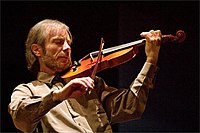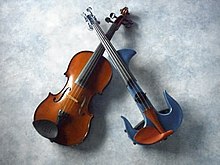Jazz violin

Jazz violin is the use of the violin or electric violin to improvise solo lines. Early jazz violinists included: Eddie South, who played violin with Jimmy Wade's Dixielanders in Chicago; Stuff Smith; and Claude "Fiddler" Williams. Joe Venuti was popular for his work with guitarist Eddie Lang during the 1920s. Improvising violinists include Stéphane Grappelli and Jean-Luc Ponty. In jazz fusion, violinists may use an electric violin plugged into an instrument amplifier with electronic effects.
Swing to bebop

Jazz violin began in New Orleans in the early 1900s.

Violin became a solo instrument in jazz largely through the efforts of
The violin is well-represented in modern jazz and improvisational music.
Amplification

Big bands are loud, but the violin is quiet. One person to address the problem was Augustus Stroh, who invented the Stroh violin in the 1890s that was inspired by the gramophone,[1] with a horn connected to project the sound. In the 1930s, Stuff Smith experimented with electric amplification.[1][2] Since the 1980s an electric violin has been used in which a transducer is built into the instrument.[1]
Jean-Luc Ponty's attraction to jazz was influenced by Miles Davis and John Coltrane, which led him to the electric violin. Critic
See also
- Swing (jazz performance style)
- List of jazz violinists
- Joe Venuti Discography
References
- ^ ISBN 1-56159-284-6.
- ^ ISBN 978-0-19-518359-7.
- ^ Iyer Voted Jazz Artist of the Year in DownBeat Critics Poll. Archived 2015-08-22 at the Wayback Machine DownBeat Magazine June 23, 2015.
- ^ "The 2014 Expanded Critics Poll". JazzTimes. 13 March 2015. Retrieved 5 August 2019.
- ^ "Regina Carter's Jazz Genealogy". NPR.org. 5 March 2014. Retrieved 5 August 2019.
- ^ Chris Haigh. "Fiddling Around the World." Retrieved February 14, 2021
- ^ Berendt, Joachim-Ernst (1976). The Jazz Book. Paladin., p301
Further reading
- Stringprovisation: A Fingering Strategy for Jazz Violin Improvisation https://helda.helsinki.fi/handle/10138/303707 by Ari Poutiainen
- Jazz Fiddle Wizard by Martin Norgaard
- Jazz Philharmonic by Randy Sabien
- Improvising Violin by Julie Lyonn Lieberman
